Ministry of Industry and Information Technology: my country's 5G users account for over 30%

Ministry of Industry and Information Technology: my country's 5G users account for over 30%
On October 26, the Ministry of Industry and Information Technology released the economic operation of the communication industry in the first three quarters of 2022, showing that the information and communication industry maintained a stable operation in the first three quarters. The revenue of telecommunications business maintained steady growth, and the total amount of telecommunications business grew rapidly; the construction of new infrastructure such as 5G and gigabit optical networks was accelerated, and the scale of network connection end users continued to expand; emerging businesses such as cloud computing grew rapidly, and new momentum for industry development continued enhanced.
1. Overall operation
The telecom business revenue achieved steady growth, and the total telecom business maintained a double-digit growth rate. In the first three quarters, the total telecommunications business revenue reached 1,197.1 billion yuan, a year-on-year increase of 8.2%. The total telecommunications business volume calculated at constant prices in the previous year increased by 21.7% year-on-year, and the growth rate was the same as the previous month.
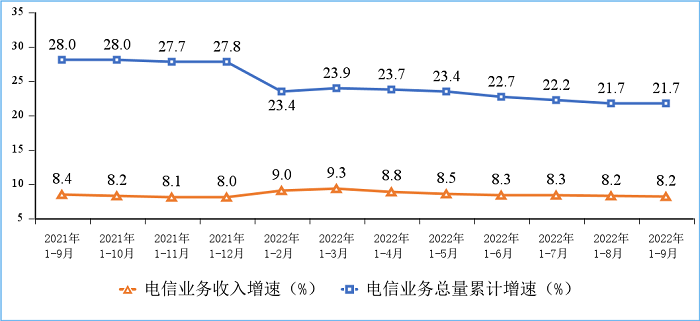
Figure 1 Cumulative growth rate of telecom business revenue and total telecom business
Revenue from fixed Internet broadband business grew steadily. In the first three quarters, the three basic telecommunications companies completed Internet broadband business revenue of 181 billion yuan, a year-on-year increase of 9%, accounting for 15.1% of the telecommunications business revenue, a year-on-year increase of 0.1 percentage points, driving the telecommunications business revenue to grow by 1.3 percentage points .
Mobile data traffic business revenue grew at a low rate. In the first three quarters, the three basic telecommunications companies achieved a mobile data traffic revenue of 488 billion yuan, a year-on-year increase of 0.7%, accounting for 40.8% of the telecommunications business revenue, driving the telecommunications business revenue to increase by 0.3 percentage points.
Income from emerging businesses grew rapidly. The three basic telecommunications companies are actively developing emerging businesses such as IPTV, Internet data centers, big data, cloud computing, and the Internet of Things. In the first three quarters, business revenue totaled 232.9 billion yuan, a year-on-year increase of 33.4%, accounting for 19.5% of the telecom business revenue. , driving the telecommunications business revenue to grow by 5.3 percentage points. Among them, cloud computing and big data revenue increased by 127.6% and 62.6% year-on-year respectively, data center business revenue increased by 14.3% year-on-year, and IoT business revenue increased by 23.5% year-on-year.
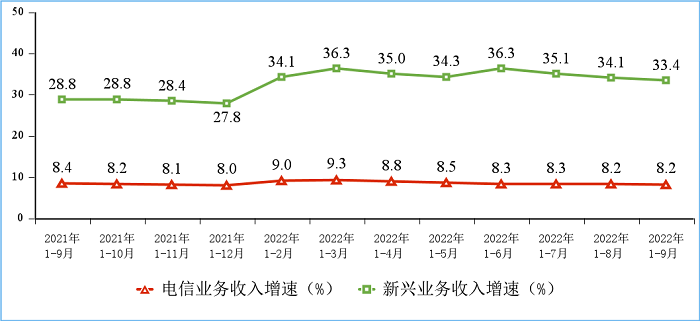
Figure 2 Emerging business revenue growth
Voice business revenue continued to decline. In the first three quarters, the three basic telecommunications companies completed fixed voice and mobile voice business revenue of 15.64 billion yuan and 85.82 billion yuan, a year-on-year decrease of 9.6% and 2.9% respectively, accounting for 8.5% of the total telecommunications business revenue, a year-on-year decrease of 1.1. percentage point.
2. Development of telecom users
The number of fixed broadband access users increased steadily, and the scale of gigabit users continued to expand. As of the end of September, the total number of fixed Internet broadband access users of the three basic telecommunications companies reached 578 million, a net increase of 42.57 million over the end of the previous year. Among them, the number of fixed Internet broadband access users with an access rate of 100Mbps and above reached 542 million, accounting for 93.8% of the total number of users, an increase of 0.8 percentage points compared with the end of the previous year; fixed Internet broadband access users with an access rate of 1000Mbps and above It reached 76.03 million, a net increase of 41.45 million over the end of the previous year, accounting for 13.1% of the total number of users.
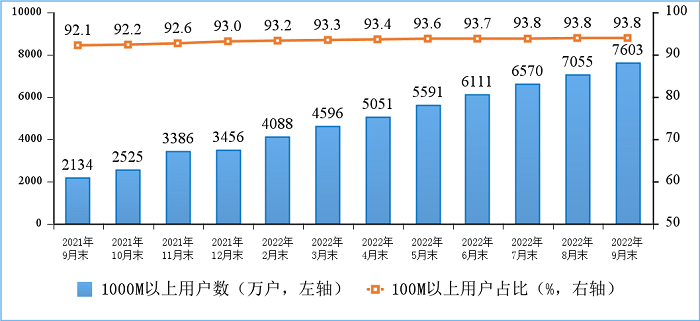
Figure 3 Fixed Internet broadband access users with rates above 100M and 1000M
The scale of mobile phone users has steadily increased, with 5G users accounting for over 30%. As of the end of September, the total number of mobile phone users of the three basic telecommunications companies reached 1.682 billion, a net increase of 38.95 million over the end of the previous year. Among them, the number of 5G mobile phone users reached 510 million, a net increase of 155 million over the end of the previous year, accounting for 30.3% of the mobile phone users, an increase of 8.7 percentage points over the end of the previous year.
The pace of "Superman" continued to increase, and IPTV users grew steadily. As of the end of September, the three basic telecommunications companies had developed 1.745 billion cellular IoT terminal users, a net increase of 350 million over the end of the previous year; the number of mobile phone users exceeded 65.86 million, accounting for the number of mobile network terminal connections (including mobile phone users and cellular The proportion of IoT end users) has reached 51%. The total number of IPTV (Internet TV) users reached 372 million, a net increase of 23.59 million over the end of the previous year.
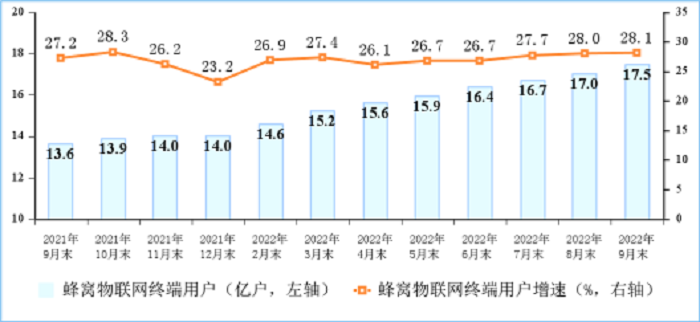
Figure 4 IoT end users
3. Use of telecommunications services
Mobile Internet traffic grew rapidly, and the monthly DOU value continued to exceed 15GB/household. In the first three quarters, the cumulative mobile Internet traffic reached 190.4 billion GB, a year-on-year increase of 18.4%. As of the end of September, the number of mobile Internet users reached 1.462 billion, a net increase of 45.97 million over the end of the previous year. In September, the average mobile Internet access (DOU) per household reached 15.01GB/household-month, a year-on-year increase of 12.4%, and was 0.29GB/household-month higher than that at the end of the previous year.

Figure 5 Cumulative access traffic and growth rate of mobile Internet

Figure 6 Monthly traffic and traffic per household (DOU) of mobile Internet access
The volume of mobile phone calls grew at a low speed, and the growth rate of mobile SMS business volume picked up slightly. In the first three quarters, outgoing calls from mobile phones reached 1.72 trillion minutes, a year-on-year increase of 1.3%; fixed-line calls reached 62.85 billion minutes, a year-on-year decrease of 10.8%. In the first three quarters, the national mobile short message business volume increased by 3.5% year-on-year, and the mobile short message business revenue increased by 1.9% year-on-year.

Figure 7 Growth rate of mobile phone users and call duration

Figure 8 Year-on-year growth of mobile SMS business volume and revenue
4. Communication Ability
The total length of fiber optic cable lines has steadily increased. As of the end of September, the total length of optical cable lines nationwide reached 58.76 million kilometers, a year-on-year increase of 6%, and a net increase of 3.956 million kilometers over the end of the previous year. Among them, the access network optical cable, the local network relay optical cable and the long-distance optical cable accounted for 62.2%, 36% and 1.8% respectively.
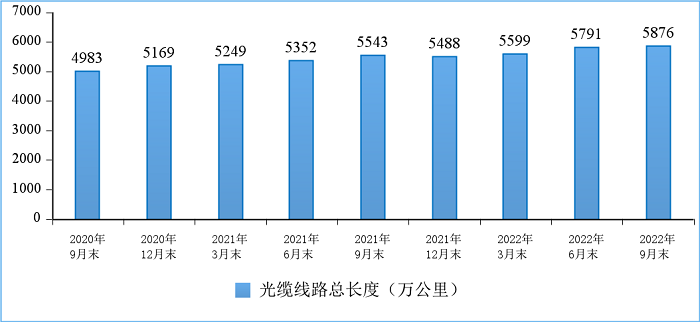
Figure 9 Development of the total length of optical cable lines
Gigabit network service capabilities continued to improve. As of the end of September, the number of Internet broadband access ports nationwide reached 1.055 billion, a net increase of 36.98 million over the end of the previous year. Among them, optical fiber access (FTTH/O) ports reached 1.008 billion, a net increase of 47.74 million over the end of the previous year, accounting for 95.5% of the Internet broadband access ports, an increase of 1.2 percentage points over the end of the previous year. As of the end of September, the number of 10G PON ports with gigabit network service capabilities reached 12.68 million, a net increase of 4.822 million over the end of the previous year.
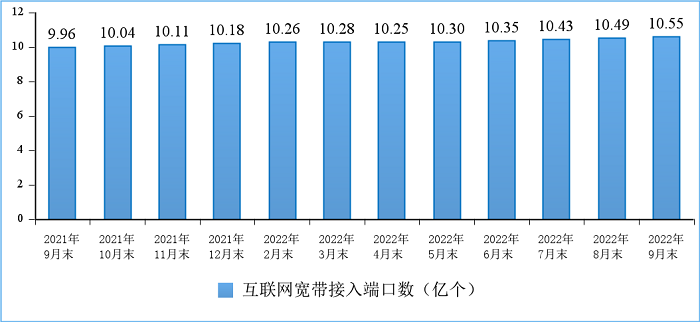
Figure 10 Development of the number of Internet broadband access ports
5G network construction continues to advance. As of the end of September, the total number of mobile communication base stations in my country reached 10.72 million, a net increase of 754,000 over the end of the previous year. Among them, the total number of 5G base stations reached 2.22 million, a net increase of 795,000 compared with the end of the previous year, accounting for 20.7% of the total number of mobile base stations and an increase of 6.4 percentage points compared with the end of the previous year.
V. Regional Development
The penetration rate of users with access to 100M and above in the central region is slightly ahead. As of the end of September, the penetration rates of 100Mbps and above fixed broadband access users in the eastern, central, western and northeastern regions were 93.6%, 94.7%, 93.2% and 93.7% respectively. The broadband access users with an access rate of 1000Mbps and above reached 38.5 million, 16.46 million, 19.1 million and 1.971 million respectively, accounting for 15.6%, 11.4%, 12.4% and 5.8% of the total fixed broadband access users in the region. .
The eastern region leads the way in 5G construction and user penetration. As of the end of September, the number of 5G base stations in the eastern, central, western and northeastern regions reached 1.069 million, 474,000, 536,000, and 140,000, respectively, accounting for 23%, 20.2%, 17.8%, and 19.8% of the total number of mobile phone base stations in the region. %. 5G mobile phone users reached 227 million, 120 million, 131 million and 33 million respectively, accounting for 31.1%, 30.7%, 29.4% and 27.9% of the total number of mobile phone users in the region.
The growth rate of mobile Internet access traffic in the central region was slightly ahead, and the DOU value of some western provinces reached a new high. In the first three quarters, mobile Internet access traffic in the eastern, central, western and northeastern regions reached 80.97 billion GB, 43.01 billion GB, 56.56 billion GB and 9.81 billion GB respectively, an increase of 18%, 20%, 19% and 11.8% year-on-year. In the three provinces of Tibet, Qinghai and Xinjiang, the average mobile Internet access (DOU) per household in September exceeded 20GB/household-month.